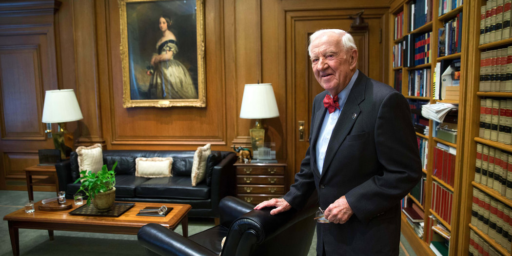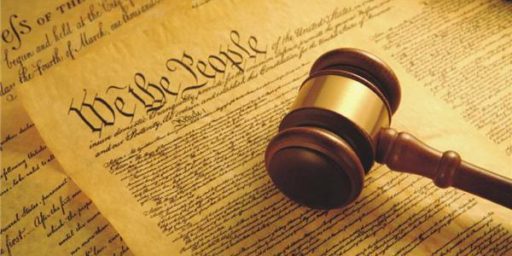Senate Democrats Fight Gregg Rescission Amendment
A source on the Senate minority staff emails that the Democratic leadership is working to block the Gregg Amendment, which would give the President rescission authority as a means to fight earmarks and other pork barrel spending bundled into omnibus bills. According to the source, “it looks like the Democratic leadership is going to try to block it. Senator McConnell is pushing to force the Senate to vote on the amendment, but Harry Reid is going to try to prevent the vote from taking place at all. ”
A recent report in The Hill by Elana Schor provides a good backgrounder:
A conservative perennial is back in season in the Senate, as GOP Sens. Judd Gregg (N.H.) and Jim DeMint (S.C.) plan a bid to restore the presidential line-item veto as part of the lobbying and ethics bill on the floor this week.
While Democrats underline their commitment to reform by touting gift and travel bans, Gregg and DeMint aim to repair their party’s bruised reputation for fiscal responsibility by billing line-item as a means to clamp down on earmarks. The House last year passed a line-item measure similar to the Senate amendment with 35 Democratic votes, but lingering concerns about the constitutionality of line-item make this week’s effort an uphill battle.
[…]
“Line-item is the title being put on this, but what it amounts to is a targeted rescission, where items in big bills that are buried there can be brought into the light of day,” Gregg said in an interview.
The latest Senate line-item plan would resemble a measure that Gregg, the Budget Committee’s ranking Republican, passed out of committee last year during his chairmanship. That bill would prevent money from rescinded projects from being used as offsets for new spending, allowing the president to propose cancellation of certain spending projects and tax benefits that would be bundled in up to four annual packages.
Congress would vote on those line-item rescissions as a group, which DeMint said would give cover to lawmakers concerned about sparking political retaliation or casting a vote against their state’s perceived interests. Giving Congress the ultimate say on cancelled projects also is intended to avoid constitutional challenges, such as the 1998 court ruling that struck down former President Clinton’s line-item authority.
DeMint compared the new line-item structure to the congressionally mandated Base Realignment and Closure Commission, which was designed to avert objections through consideration of closures as a group. Though DeMint was one of only eight senators to vote against last year’s lobbying and ethics bill, he left the door open to supporting this year’s version.
While I support the idea — and am assured by my source that “Even Harry Reid isn’t arguing against it on Constitutional grounds” — it’s not entirely clear that “rescission” is not simply another way of saying “line-item veto.” Here’s how CNN reported the 1998 SCOTUS decision striking down the line-item veto:
The line-item veto is unconstitutional, the Supreme Court decided Thursday, ruling that Congress did not have the authority to hand that power to the president.
The 6-3 ruling said that the Constitution gives a president only two choices: either sign legislation or send it back to Congress. The 1996 line-item veto law allowed the president to pencil out specific spending items approved by the Congress.
In his majority opinion Justice John Paul Stevens upheld a lower court’s decision, concluding “the procedures authorized by the line-item veto act are not authorized by the Constitution.”
If Congress wants to give the president that power, they will have to pass a constitutional amendment, Stevens said. “If there is to be a new procedure in which the president will play a different role in determining the text of what may become a law, such change must come not by legislation but through the amendment procedures set forth in Article V of the Constitution,” Stevens said.
Granting the executive the right to “rescind” parts of bills strikes me as identical to this. There may be some technical way around this but I’m not sure what it might be.
It is fundamentally different from the BRAC idea, which gives a blue ribbon panel the responsibility for coming up with a list of bases to close and re-align and requires Congress to vote up or down on the whole package as political cover. There, Congress ultimately passes legislation and the president signs it. The Constitution is virtually silent on how legislation is drafted.
UPDATE: A PRNewswire-USNewswire description sheds different light on the subject:
The amendment . . . would allow the President to propose the elimination of individual expenditures and special tax breaks in legislation without having to veto the entire bill. For any such rescission package to become law, both chambers of Congress would have to approve it without amendment by majority vote. Any member of Congress could fast-track consideration of the rescissions for a vote in that chamber within eight days.
Now that might be a different story. If all that’s happening is:
-
1. Congress passes bill;
2. President looks and bill, suggests changes to bill to Congress;
3. Congress votes whether to change/not change bill;
4. President either signs changed bill, signs unchanged bill, or vetoes unchanged bill.
Then there’s no obvious Constitutional problem. Then again, there’s no obvious reason the president couldn’t do that without the Gregg Amendment. Indeed, presidents do 2 all the time, usually sometime before 1 takes place.
UPDATE: Rob Port would prefer that Congress restore the president’s impoundment power which was stripped with the 1974 Budget Act.






When I think about this, I ask myself does a President really, really want this power conferred on him. Being the very visible top of the heap in the executive branch, does a President want to be responsible for being blamed for not eliminating an earmark with no blame falling on the shoulders of the porker who originally slipped the earmark into a bill in thhe first place? I am sure it would be only a short matter of time before those accusations arose. Plus, many Presidents likely find themselves not having a large same party congressional majority with which to ease their agenda through the legislative process. Will a President then have to worry what kind of coalition he can build for his programs depending upon who he offends by eliminating particular earmarks? I am not sure this executive privilege will prove as efffective as believed.
I agree this amendment appears to be either: 1) not what the President’s job is within the legislative process or 2) merely reaffirming what the President’s job is within the legislative process.
Either/or the whole thing is meaningless grandstanding by McConnell, Demint, Gregg, et al.
Sure looks unconstitutional to me. The courts have generally been hardasses on the veto. If a bill is passed, the President can either pass it or veto it. End of story. The current bill seems to cut out some middlemen, but those middlemen (veto, resubmission, repassage) are probably constitutionally requred.